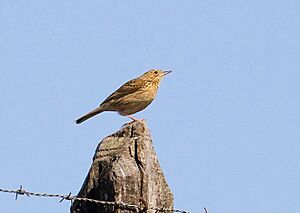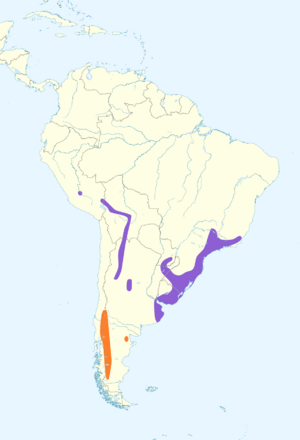Hellmayr's pipit facts for kids
Quick facts for kids Hellmayr's pipit |
|
|---|---|
 |
|
| Conservation status | |
| Scientific classification | |
| Genus: |
Anthus
|
| Species: |
hellmayri
|
 |
|
The Hellmayr's pipit (Anthus hellmayri) is a small bird that belongs to the Motacillidae family. This family also includes wagtails and longclaws. You can find this bird in several countries in South America. These include Argentina, Bolivia, Brazil, Chile, Paraguay, Peru, and Uruguay. It likes to live in open areas like grassy fields. It can be found in temperate grasslands, high-altitude tropical grasslands, and even pastures.
Contents
How Scientists Classify Hellmayr's Pipit
Scientists like to group living things to understand them better. This is called taxonomy. The Hellmayr's pipit was first described in 1909 by a scientist named Ernst Hartert. He placed it in the Anthus group, which is where pipits belong.
This bird was named after an Austrian bird expert, Carl Eduard Hellmayr. There are three main types, or subspecies, of Hellmayr's pipit that scientists recognize:
- A. h. hellmayri: This type lives in the southern Peruvian Andes, Bolivia, and a rainforest area in Argentina called the Tucumán rainforest.
- A. h. dabbenei: You can find this type in the Andes mountains of western Argentina and nearby parts of Chile.
- A. h. brasilianus: This type lives in Brazil, south of Minas Gerais, stretching into Uruguay and parts of Argentina. It also lives in southern Paraguay.
What Hellmayr's Pipit Looks Like
The Hellmayr's pipit is a medium-sized bird. It usually weighs about 18.6 grams, which is less than a handful of coins. Its legs are pink, and its beak is a light pink color.
The feathers on its back have clear, dark streaks. However, the feathers on its chest and sides have only faint streaks. It can sometimes be mistaken for the Short-billed pipit. But you can tell them apart because the Hellmayr's pipit has a plain white throat. The Short-billed pipit has streaks on its throat and a white stripe under its beak.
The eggs of the Hellmayr's pipit are oval-shaped. They are white with small brown speckles.
Where Hellmayr's Pipit Lives
Hellmayr's pipits live in three separate areas across the southern part of South America. One group lives in the Andes mountains. This area stretches from southern Peru, through Bolivia, and into northwestern Argentina. Another group lives in the Andes of southern Argentina and Chile.
The third group, known as A. h. brasilianus, lives in the eastern part of the continent. They are found from the Espinhaço Mountains in Brazil, all the way south into Uruguay and eastern Argentina. They also live west into the Gran Chaco region of Paraguay. These birds can live in many different elevations, from sea level up to 3,700 meters high in the mountains.
Hellmayr's Pipit Behaviour and Life Cycle
For most of its range, the Hellmayr's pipit stays in the same area all year round. Its breeding season, when they have their young, happens during the rainy season. This is usually from September to April.
During breeding season, male pipits perform special aerial displays. They fly in patterns in the air to attract females. The pipits living in Chile and southern Argentina (the A. h. dabbenei type) are known to migrate. This means they move to different areas during certain times of the year.
Hellmayr's pipits mainly eat insects. Their nests are shaped like a cup and are built on the ground. They often build them inside grass mounds. The nest has a dome-shaped roof made from dry stems and grass. A female pipit can lay up to five eggs at a time. Both the mother and father pipit help feed the young birds once they hatch.


